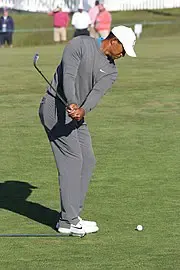“Gap” is the difference in loft, or distance, between clubs.
It’s essential to have the correct “gap” between clubs, particularly wedges.
For wedges, you typically want 4-6 degrees of loft, or 10-15 yards, between wedges.
So, a player with a pitching wedge loft of 43° would want an approach (or gap) wedge with a loft of 48°, and a player with a PW loft of 47° would want an AW with a loft of around 52°.
What Are The Different Types Of Wedges?
Here is a chart of typical wedge lofts:
| Club | PW | AW | SW | LW |
| Loft | 42-47° | 48-52° | 54-58° | 58-64° |
These are general ranges, but I have seen game-improvement pitching wedges with lofts as low as 38 degrees (Titleist T400).
If you buy your irons (for example, 4-PW) in a set, they will be properly gapped.
Related: Pitching Wedge Loft: What Degree Is A Pitching Wedge?
What Wedges Come With Certain Sets?

If you buy a game improvement set, they will likely come with a gap wedge, sand wedge, and sometimes even a lob wedge. In this case, your wedges should be gapped appropriately, and a quick range session can confirm this.
Many players buy a set of 3-PW or 4-PW. In this case, you must ensure that the additional wedges you buy are properly gapped.
Most player distance iron sets come with the option of including an AW. If you choose to include it, you only need to worry about properly gapping a sand wedge (SW) and possibly a lob wedge (LW).
That said, most better players or those who have been playing for a while will choose to purchase all wedges other than a PW separately.
They will get a PW in the same model as their higher lofted irons and then buy whatever extra wedges they need.
Players will typically carry 2 or 3 wedges in addition to a pitching wedge.
Your approach wedge loft will depend solely on the loft of your PW and your SW. You will want the loft to be right in the middle of those.
How To Properly Gap Your Wedges
To properly gap your wedges, figure out the loft of your PW and the loft of the highest lofted club you plan to carry.
There are two ways to determine how many additional wedges you need.
The first way is sufficient for the vast majority of players, and entails gapping your wedges mainly based on loft.
The second way is how better players, particularly pros, will gap their wedges and entails gapping wedges mainly by distance.
- Calculate the difference in loft between your PW and SW/LW.
- If it is greater than 12 degrees, you need two additional wedges.
- If it is between 10-12 degrees, it’s up to you whether you want an additional wedge or an additional longer club.
- If it’s less than 10 degrees, you only need one additional wedge.
- Figure out how far you hit your PW and how far you hit your highest lofted wedge.
- Then determine how much gap, or yardage difference, you want between each club.
- This method is highly subjective and personal. Some players will never hit a full LW or even SW. Others will want a tighter gap between certain wedges than others. This method is only effective with advanced players due to the consistency of strike required to gap wedges accurately.
- This method also requires access to high-tech equipment such as Trackman or other ball flight software.
What Wedges Should You Carry?

In addition to a pitching wedge, most players will carry two or three wedges.
Here are some examples of how to determine how many you should carry:
Determine Number Of Wedges By Loft
- You have a 45 ° PW and want to carry a 60° LW
- You should get two wedges: 50 and 55°.
- You have a 47-degree PW and a 58-degree SW
- You likely only need one wedge: a 51 or 52° wedge.
Determine Number Of Wedges By Distance
- Your PW carries 130, and your LW carries 90.
- You should get two wedges. One that carries 100-105 and one that carries 115-120.
- You could just get one wedge that carries about 110, but 20 yards is a fairly significant gap between wedges. And if you can fly your PW 130, you likely hit the ball far enough that it’s more beneficial for you to carry an extra wedge than an extra wood, hybrid, or long iron.
- Your PW carries 115, and SW carries 85.
- You should get one additional wedge that carries around 100.
- Related: How Many Clubs In A Golf Bag?
Wedges Can Easily Be Bent For Proper Gapping
Most manufacturers carry wedges in lofts of 50-64° in increments of 2.
If those lofts don’t fit with your PW or other wedges, they can easily be bent 1 degree either way.
For example, say your pitching wedge is 46, and you want to add a gap wedge and a sand wedge.
You could buy a 52 degree gap wedge, have it bent to 51 degrees, and buy a 56 degree wedge. That way, all three of your wedges are now 5 degrees apart.
Or if you have a 46 degree PW and a 56 degree SW, you could buy a 52 degree gap wedge and have it bent to 51 degrees.
Proper Gapping Is Personal

Ultimately, all that matters is that you feel comfortable with the gap between your wedges.
If you have no confidence hitting a full sand wedge, then don’t. Figure out how far you are comfortable hitting it and determine what additional wedges you need from there.
As you improve as a player, you will become more consistent with how far you hit each club.
The fine-tuning of bending wedges a degree is only beneficial to good players who need their wedge distances to be dialed in down to the yard.
Most pros will have a 3/4, full, and max distance for each wedge. This allows them to ensure that they can hit every type of shot at every possible distance.
If you aren’t at least a single-digit handicap, don’t worry about bending your wedges a degree. Just make sure you have a 4–6-degree gap between all wedges, and you’ll be good to go.
Related: What Does Up And Down Mean In Golf?

